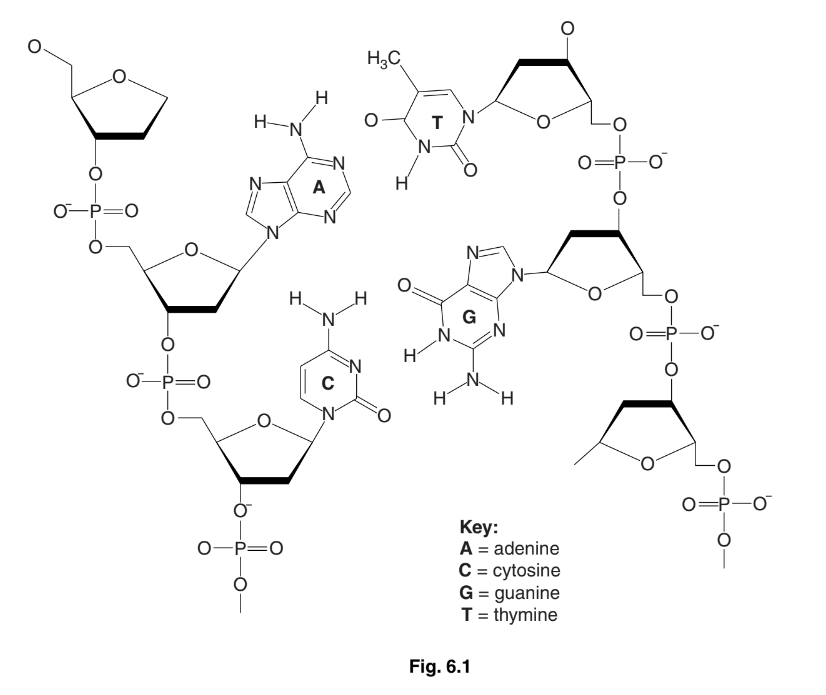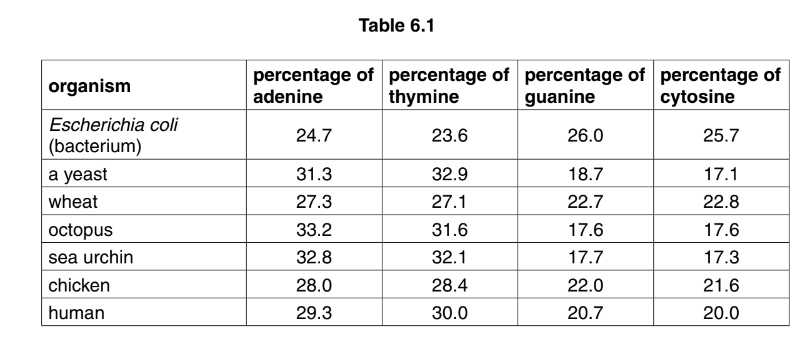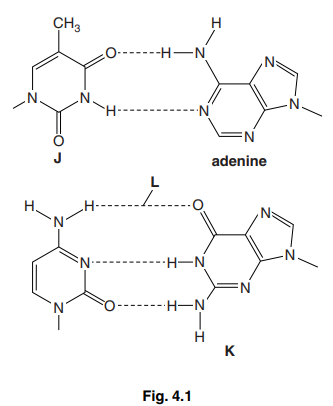Question [Maximum marks: 9]
Fig. 6.1 shows part of a DNA molecule.

(a) (i) Complete Fig. 6.1 by drawing on the hydrogen bonds between the two base pairs
shown.
(ii) State the importance of hydrogen bonding in DNA structure.
In the 1950s, Erwin Chargaff determined the relative quantities of the four bases in DNA in
different organisms. His results provided important evidence for the model of DNA proposed
by James Watson and Francis Crick in 1953. Some of Chargaff’s data is shown in Table 6.1.

(b) With reference to Fig. 6.1, explain how the data in Table 6.1 helps to confirm the
arrangement of bases in DNA.
(c) Table 6.2 shows Chargaff’s data for a virus.

(i) State how the result for the virus differs from the results for all the organisms given in Table 6.1.
(ii) Suggest why the results for the virus are different from all the other organisms.
Answer/Explanation
Answer: 6(a) (i) hydrogen bonds drawn onto Fig. 6.1
lines must go between O-H, N-H as follows
two lines between A and T H – O and N – H ;
three lines between C and G H – O and N – H and O – H ;
(ii) 1 hydrogen bonds hold (two), polynucleotides / strands / chains, together ;
A hold, (complementary) nucleotides / base pairs, together
A ora e.g. prevents, unwinding / strand separation
2 (many hydrogen bonds) give stability / DNA is stable molecule / DNA is long lasting / AW ; ignore ref. to strength 3 can be broken for, transcription / replication ;
4 ref. to (double) helix ;
6(b) 1 (named) base / nucleotide, pairing ;
2 purine – pyrimidine ;
3 percentage of A = percentage of T ; A very similar
4 percentage of C = percentage of G ; A very similar
5 data quote in support ; [max 3]
6(c) (i) idea that
percentages of, A and T / C and G, are not the same / three percentages are similar;
(ii) single-stranded DNA / not double-stranded / not a double helix ;
A may be other bases ;
Question
Fig. 4.1 shows the two base pairs in a DNA molecule.

(a) Name the bases labelled J and K and the bond labelled L.[3]
J
K
L
HIV enters T-lymphocytes by a form of endocytosis. Two of the enzymes in HIV are:
- reverse transcriptase, which uses viral RNA as a template to make DNA to incorporate into the chromosomes of the host’s cells
- protease, which is used to break a polypeptide into smaller molecules. These molecules are used to make the protein coat of new viral particles, which will infect other cells.
Various drugs have been developed to treat HIV infections. Table 4.1 gives information about some of these drugs.

(b) Explain the difference between the mode of action of zidovudine and efavirenz.[4]
(c) People who receive drug treatment for HIV take a mixture of drugs that act in different ways.
Suggest the advantage of taking a mix of the drugs shown in Table 4.1.[2]
(d) Antibiotics are prescribed to people who have HIV/AIDS for the treatment of secondary infections, but not to treat the HIV infection.
Explain why this is so.[2] [Total: 11]
Answer/Explanation
Ans:
4 (a) J thymine ;
K guanine ;
L hydrogen bond ;
ignore H/H2 bond
(b) 1 zidovudine , competitive inhibitor and efavirenz , non-competitive ;
2 zidovudine, complementary to active site ;
3 efavirenz, binds to allosteric site/reference to allostery ;
4 efavirenz changes the, shape/ structure, of the active site ;
A denatures / changes tertiary structure so substrate will not fit
R changes shape unqualified
5 either
the effect of zidovudine is, reduced/reversed, by increasing the substrate
concentration
or
the effect of efavirenz is not, reduced/reversed, by increasing the substrate concentration ;
(c) 1 virus may be resistant to one or more of the drugs / very low chances that HIV is resistant to all of the drugs ;
R virus immune
2 (resistance due to) change to, active site/ allosteric site/ tertiary structure, of enzyme ;
A drug can no longer fit into active site
3 some drugs may be more effective than others /AW ;
4 reduces risk of drug resistance developing ;
5 HIV, has a high mutation rate/ changes surface proteins / changes antigens ;
A antigen(ic), shift/ drift
6 person may have mixture of strains of HIV ;
7 idea that virus will be at different stages in its, life/replication, cycle ;
8 AVP ;
e.g. more than one competitive to reduce chances of, ES complexes /AW
drugs work better in combination/ synergy idea
drugs inhibiting two different enzymes, so more effective
(d) 1 antibiotics are not effective against HIV or viruses / antibiotics are effective against, (named) bacteria/ bacterial disease ;
A fungi/ protoctists / protists / malaria
R antibiotics prevent infection
2 idea that viruses have no, sites / targets, where antibiotics can work ;
3 viruses have no, cell walls /ribosomes / cell membranes ;
A have different enzymes
4 viruses are within cells, idea that antibiotics cannot reach them ;
5 people with HIV are more susceptible to bacterial infections /reference to immune suppression/weak immune system ;
Question
(a) State the name of the causative organism (pathogen) of measles. [1]
(b) Describe how the measles pathogen is transmitted. [2]
(c) The measles pathogen contains a single stranded RNA molecule and no DNA.
The cells that the measles pathogen infects contain double stranded DNA molecules.
State two other ways in which the RNA in the measles pathogen differs from the DNA in the infected cells.[2]
1
2
(d) The measles pathogen must carry out RNA replication to make new RNA molecules for the new pathogens. This happens inside the infected cell.
The pathogen carries its own enzyme for RNA replication, but no other enzymes.
Explain why the measles pathogen cannot use an enzyme from the cell to carry out RNA replication.[2]
(e) The outer part of the measles pathogen contains an antigen called the H-protein. This antigen appears on the surface of cells infected with the measles pathogen.
Describe the role played by T-lymphocytes in a primary immune response to an infection by the measles pathogen.[5] [Total: 12]
Answer/Explanation
Ans:
5 (a) Morbillivirus ;
(b) must have one ref. to either infected or uninfected to gain max
aerosol, infection/route ; A droplet infection I ref. to contact
infected person, sneezes / coughs / talks / spits, to release airborne droplets;
inhaled by, uninfected/ healthy, person ;
(c) RNA nucleotides ;
contains uracil ; A no thymine
ribose (instead of deoxyribose) ;
no (double) helical structure ;
AVP ; e.g. small enough to pass through nuclear pores ;
(d) cell has no enzyme for RNA replication ;
ref. to enzyme specificity ;
RNA polymerase (in cell) uses DNA template/ not RNA template/AW ;
(e) ref. to recognition and activation by presence of antigen (on APCs / infected cells) ;
T helper and T killer, lymphocytes / cells ; A T cytotoxic
T helper
secrete cytokines ;
(cytokines) stimulate/AW, (specific) B-lymphocytes ; A humoral response
stimulate/AW, macrophages / phagocytes /phagocytosis /T killer response ;
T killer
kill infected cells ;
detail of killing ; e.g. perforin/H2O2
punching ‘holes’ in membrane
ref. to T lymphocytes become memory cells (for secondary immune response) ;
